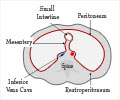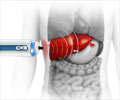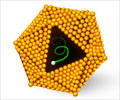Calcipotriol - a synthetic form of vitamin D could be used as a potential new treatment for liver disease, say scientists.

In industrialized countries, the main causes of liver injury leading to fibrosis include chronic hepatitis virus infection, excess alcohol consumption and, increasingly, nonalcoholic steatohepatitis (NASH).
In a new study, Salk scientists discovered that calcipotriol deactivates the switch governing the fibrotic response in mouse liver cells, suggesting a potential new therapy for fibrotic diseases in humans.
"Because there are currently no effective drugs for liver fibrosis, we believe our findings would open a new door for treatment," said senior author Ronald M. Evans, a professor in Salk's Gene Expression Laboratory and lead researcher in the Institute's new Helmsley Center for Genomic Medicine.
The Salk study focused on a star-shaped "stellate" cell in the liver that serves as a beacon for damage. When called into action, stellate cells produce fibrotic proteins in an attempt to heal an injury. Under chronic stress, however, localized fibrosis expands, eventually leading to cirrhosis, increased risk of liver cancer, and the need for a liver transplant in advanced cases.
The Evans lab discovered a genetic switch through which vitamin D-related ligands such as calcitriol, a hormonally active form of the vitamin, can put the brakes on fibrosis.
Advertisement
Previous studies have shown a physiologic role for vitamin D in liver function, but "it was our discovery of high levels of vitamin D receptor (VDR) in the stellate cell that led us to consider it as a possible off switch for liver fibrosis," stated lead author Ning Ding, a research associate in the Gene Expression Laboratory.
Advertisement
"In liver diseases where the underlying cause cannot be cured, progression to cirrhosis is currently inevitable in some people. What we have discovered is that by acting on the genome, VDR can simultaneously defend against multiple fibrotic activators. This is important because many different pro-fibrotic signaling pathways converge on the genome to affect their fibrotic response."
The Salk discovery that calcipotriol counters the fibrotic response in stellate cells illuminates a potentially safer, more effective strategy capable of neutralizing multiple convergent fibrotic triggers.
The Salk scientists say that clinical trials of the vitamin D analog for the treatment of liver fibrosis are being planned. The synthetic vitamin D analog is better than natural vitamin D, they said, for a couple of reasons.
First, natural vitamin D, which is found in small amounts in a few foods and produced in the body by exposure to sunlight, degrades quickly, while synthetic versions of vitamin D are less susceptible to breakdown. Second, too much natural vitamin D can cause hypercalcemia, or elevated calcium in the blood, which can lead to nausea and vomiting, frequent urination, muscle weakness and joint aches and pain.
The synthetic vitamin D analog, on the other hand, produces a strong response without adding calcium to the blood.
In addition, the researchers said that this new model for treating liver fibrosis may also be helpful in treating other diseases with a fibrotic component, including those of the lung, kidney and pancreas.
The study appeared in the journal Cell.
Source-ANI















